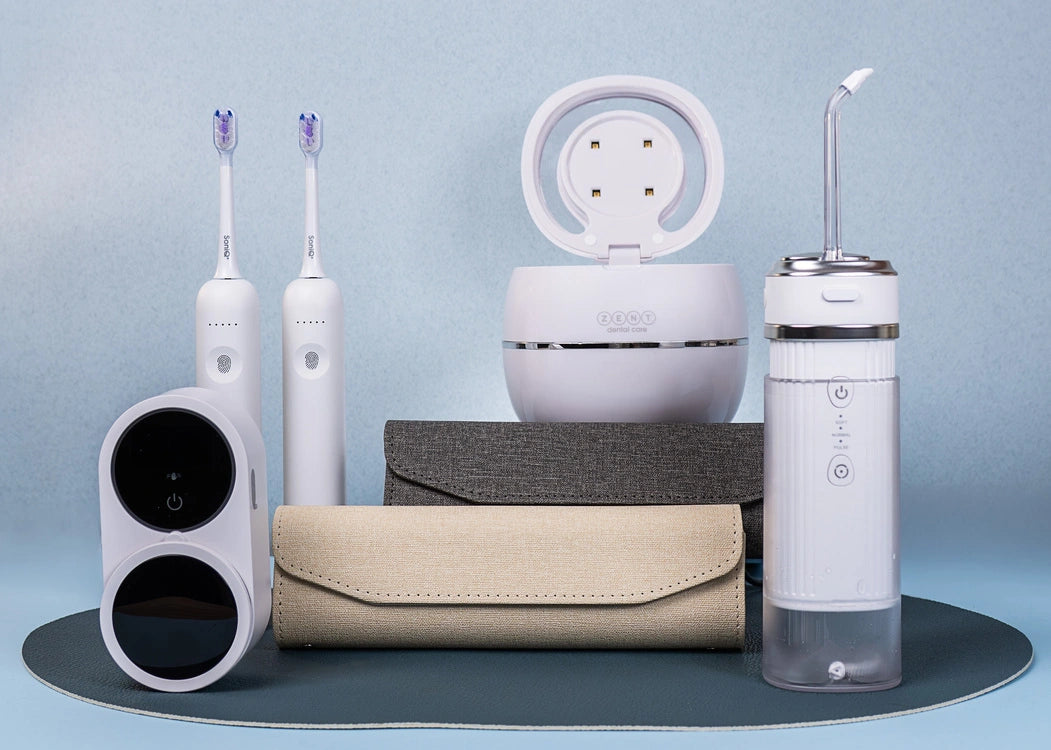The best ways to maintain youthful skin
A youthful skin appearance is the result of conscious care and consistent habits, not just genes. UV radiation is responsible for 90% of premature aging by destroying collagen and elastin,...
At ZENT Care, we focus on technologies that work. Each of our devices is created based on proven technological solutions, clinical research, and years of experience in manufacturing care devices. From ultrasound to LED phototherapy, from shiatsu massage to brushless motors – we use what truly delivers results.

Dental care
Ultrasound and sonic waves. Our dental devices use ultrasonic technology (up to 42 kHz) and sonic technology (up to 42,000 vibrations/min) known from professional dental offices. Scientific research confirms the effectiveness of ultrasound in removing bacterial biofilm, dental plaque, and deposits from dentures, orthodontic aligners, and retention appliances. Without the risk of mechanical damage.
Materials and precision. Stainless steel, safe plastics, certified contact materials – every element of our devices undergoes quality control.
Additionally, we offer disinfection systems with UV-C technology that eliminate 99.9% of bacteria and viruses from toothbrushes, ensuring hygienic storage between uses.
vital care
Shiatsu massage and 6D technology. ZENT Vital devices use traditional Japanese shiatsu massage techniques (acupressure) and modern 6D technology, which simulates the hand movements of a professional masseur. Shiatsu massage has been used for years in physiotherapy and natural medicine as a method supporting muscle regeneration and improving circulation.
Brushless motors. Our massagers are equipped with next-generation brushless motors – quieter, more efficient, and more durable than traditional brushed motors. They provide precise power control, long battery life, and stable performance over years of use.
Thermotherapy. The heating function up to 45°C supports tissue regeneration, improves blood circulation, and enhances the relaxation effect. Heat has been used for centuries in pain therapy and muscle regeneration – our devices combine this natural method with modern massage technology.


Beauty care
LED light therapy. ZENT Beauty devices use LED phototherapy – a technology used in beauty salons and aesthetic medicine clinics. Clinical studies confirm the effectiveness of three light wavelength lengths:
Medical-grade materials. ZENT Beauty masks are made of medical silicone – hypoallergenic, breathable, and safe for all skin types, including sensitive skin. The ergonomic 3D design ensures the optimal distance of the LED diodes from the skin, eliminating the risk of overheating and maximizing the effectiveness of the therapy.
The influence of orthodontic fixed appliances on the oral microbiota: a systematic review
An assessment of the effectiveness of mechanical and chemical cleaning of Essix orthodontic retainer.
Chang, C. S., Al-Awadi, S., Ready, D., & Noar, J. (2014). Journal of Orthodontics,41(2), 110–117. https://doi.org/10.1179/1465313313Y.0000000088
The Effect of Orthodontic Appliances on the Distribution of Candida and Plaque in Adolescents.
Orthodontic treatment with fixed appliances and biofilm formation—a potential public health threat?
Ren, Y., Jongsma, M.A., Mei, L.et al. .Clin Oral Invest 18, 1711–1718 (2014). https://doi.org/10.1007/s00784-014-1240-3
The Association of Orthodontic Treatment and Fixed Retainers With Gingival Health.
Levin, L., Samorodnitzky-Naveh, G.R. and Machtei, E.E. (2008), Journal of Periodontology, 79: 2087-2092. https://doi.org/10.1902/jop.2008.080128
Lombardo, L., Martini, M., Cervinara, F.et al. Prog Orthod.18, 26 (2017). https://doi.org/10.1186/s40510-017-0178-9
A youthful skin appearance is the result of conscious care and consistent habits, not just genes. UV radiation is responsible for 90% of premature aging by destroying collagen and elastin,...
The massager is a tool that supports muscle regeneration, pain relief, and improved well-being, which can be used at different times of the day depending on needs. In the morning,...
After the age of 30, collagen production gradually decreases, cell regeneration slows down, and the skin loses firmness and becomes drier. Fibroblasts work more slowly, the renewal cycle lengthens, sebum...
Scientific studies confirm that massage truly helps in combating stress, although the mechanisms are more complex than commonly believed. Massage improves mood, reduces tension and lowers anxiety levels, decreases heart...